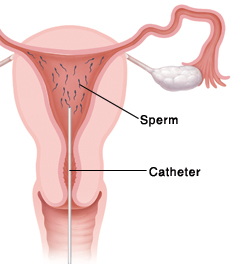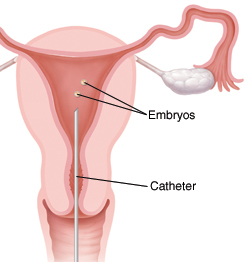Understanding Fertility Problems: Assisted Reproduction
For certain problems, or if other treatments haven't helped, your doctor may recommend assisted reproduction technologies (ART). In most cases, these methods use hormone medications to increase the chances of success. Be sure to talk with your doctor about the details, success rates, and costs of these procedures.

During IUI, sperm are injected into the uterus to improve the chances of fertilization.
Intrauterine Insemination (IUI)
IUI is a fertility treatment that places sperm in the uterus during ovulation. It can be done in your doctor's office or a clinic. There are 2 main steps in the process:
-
First, the man's semen is "washed" in a lab. This separates active sperm from the semen.
-
The sperm are then placed inside a thin tube called a catheter. The catheter is inserted through the woman's cervix and the sperm are placed into the uterus.
In most cases, IUI is done using hormone medications that enhance a woman's fertility (a "stimulated cycle"). It can also be done without medications (a "natural cycle").

During IVF, a catheter is carefully guided through the cervix to transfer embryos into the uterus.
In Vitro Fertilization (IVF)
During IVF, sperm and egg are combined outside the body in a lab. There are 4 main steps in this process:
-
Medication is used to stimulate the ovaries to develop multiple mature eggs.
-
The mature eggs are retrieved from the ovaries. This is done by guiding a thin needle through the vagina. Sedation is used to prevent pain.
-
Sperm are combined with the eggs in a lab. If there are problems with fertilization, one sperm can be injected directly into an egg. This process is called intracytoplasmic sperm injection (ICSI).
-
A few days after fertilization, one or more embryos are placed into the uterus. Using multiple embryos improves the odds that at least one embryo will implant. However, it also means there is a chance of a multiple pregnancy.
Transferring Embryos
A thin tube called a transfer catheter is used to transfer embryos from the lab into a woman's uterus. This is often done about 3 days after fertilization. In some cases, your doctor may wait a day or two longer to use a more developed embryo (called a blastocyst).
Using Frozen Embryos
Although many embryos are created during an IVF cycle, only a certain number are placed into the uterus. The remaining embryos may then be frozen for later use. This prevents the woman from having to go through another cycle of egg stimulation and retrieval.
Sperm Donation
If there are problems with a man's sperm, donor sperm can be used to inseminate the woman. The sperm can be obtained from a known donor or a commercial sperm bank. Be assured that all donors are tested for diseases such as HIV/AIDS. They're also tested for genetic diseases, such as cystic fibrosis. Sperm banks also allow you to match the donor's physical traits to the male partner.
Egg Donation
If treatments for ovulation problems are unsuccessful, egg donation may be an option. The eggs can come from a known donor, such as a sister. Or, they can come from a commercial agency. Like sperm donors, egg donors are tested for sexually transmitted diseases and genetic problems. You also have the option of matching the donor's physical traits to the mother.
Surrogacy
If a woman cannot produce eggs or maintain a pregnancy, surrogacy can be an option. In traditional surrogacy, another woman gives birth to a child conceived with her egg and your partner's sperm. With gestational surrogacy, another woman gives birth to a baby conceived with your egg and your partner's sperm. Be sure to explore all the legal and emotional aspects of this option.

